|
Michael McFadyen's Scuba Diving - Douglas A-20 Havoc
HISTORY OF DOUGLAS A-20
On 26 October 1938 a privately developed aircraft made its first flight at El Segundo in California. Designed by Jack Northrop and Edward Heinemann, and originally developed to meet a US Army Air Corps attack specification, the new plane was powered by twin engines and had a tricycle undercarriage. Unfortunately, this plane was destroyed in a fatal crash on 23 January 1939. It appears that the plane failed to gain the US order and was further developed to meet an order for 100 placed in February 1939 by the French Government for the Armee de l'Air. The new aircraft, a high winged twin engine attack bomber, was at first called the Douglas DB-7. On 17 August 1939 the first production aircraft made its maiden flight. In January 1940 the first deliveries began of the plane to the French and on 31 May 1940 they began operations.
 |
| This is a British Boston III but it is the same as the US Havoc A-20A and looks like the plane in Port Moresby |
After the fall of the French Government, the remaining aircraft from the order and additional planes were delivered to the British Government and an order was also placed for more aircraft and an order also placed by the US. The new plane was known by a variety of names. The British called it the Boston, while the US called it the A-20 Havoc and it also went by the designations BD-2, F-3 and P-70.
After 63 A-20 aircraft, the sub-type changed and the Douglas A-20A was the first produced in numbers (153).
Planes were built at the El Segundo (all 63 A-20s, all 153 A-20As), Long Beach (all 998 A-20Bs), California and Oklahoma City (668 A-20Bs and all 2,850 A-20Gs) plants as well as by Boeing (140 A-20Cs) at (I think) Seattle, Washington. I do not know where the 402 A-20Hs and the 450 A-20Js were built. Many of these planes were converted to other variants.
Model A-20A
The Douglas A-20A Havoc attack bomber was 14.6 metres long with a 18.7 metre wingspan. It was powered by two 1,600 hp Wright R-2600-11 Double Cyclone 14 cylinder two row radial engines with two speed supercharger with three-bladed propellers. These gave the plane a maximum speed of about 475 to 500 kph and a cruising speed of 439 kph. Maximum take-off weight was perhaps 7,575 kg (later versions 12,338 kg). Range was 1,600 to 1,754 km at normal bomb load. Armament for the A-20A was originally two 0.303 inch Browning machine guns on each side of the lower nose. The two outer ones were in a fixed gun blister while the other two were mounted inside the nose.
The plane also had a twin 0.303 machine gun in the dorsal gun position as well as a single 0.303 machine gun under the fuselage for attacks from below and behind. Additional Browning guns could also be mounted in the rear of each engine nacelle. These were pointed straight back and operated by the dorsal gunner using a foot pedal. Bomb capacity was 454 kg (about 1000 lbs). Crew was pilot, dorsal gunner and nose gunner/bomb-aimer.
In 1940 two Douglas A-20A-DE Havoc attack fighter/bombers (DE signifying Douglas and El Segundo), serial numbers 40-176 and 40-173, were built at the El Segundo plant. These were allocated to the 89th Bomb Squadron of the 3rd Bombardment Group and both eventually ended up in New Guinea.
While in Australia on the way to New Guinea (see later for details), the planes were amongst many modified. The bomb aimer's position was removed and the glass nose replaced with an aluminium nose (see the photo of "Strawberry Roan" below left compared to the Boston III above right). The planes were modified while in Brisbane (at the Royal Australian Air Force base at Amberley). These modifications were under the guidance of Captain (later Lt Colonel) Paul Irving "Pappy" Gunn and USAAC 8th Bombardment Squadron Commander, Bob Ruegg. Gunn decided to replace the existing four nose .303 machine guns with 50 calibre guns and add another two or perhaps four.
These planes only had a pilot and dorsal gunner. There was no nose gunner/bomb aimer as the nose was modified to include more guns. The planes appear to have had two or four nose guns, two guns in flared pods on the bottom side of the nose and two more guns inboard of these guns (a total of six or eight guns).
89TH BOMB SQUADRON, 3RD BOMBARDMENT GROUP, FIFTH AIR FORCE
The US Army Air Corps (USAAC) 89th Bomb Squadron as part of the 3rd Bombardment Group (also reported as 3rd Bomber Group and 3rd Attack Group) moved to Australia arriving in Brisbane, Queensland, on the SS Ancon on 25 February 1942 after 25 days at sea. They set up camp at Ascot, opposite Eagle Farm Racecourse. The 3rd Bombardment Group comprised 17 officers and 784 enlisted men who had no aircraft and very few ground vehicles. As well as the 89th Squadron, there were also the 8th, 13th and 90th Bomb Squadrons. On 10 March 1942 they moved to Charters Towers, Queensland (1070 km north-west of Brisbane and 107 km south-west of Townsville). The 89th Bomb Squadron became part of the Fifth Air Force at this time.
In late March or early April the 8th Squadron received old Douglas A-24 Dauntless dive bombers but the other squadrons remained without planes. The 89th Squadron did not get their planes till August 1942. Captain Paul Irving "Pappy" Gunn modifed the 24 planes received by adding four 0.50 calibre guns to the nose and replacing (I think) the two 0.303 machine guns in the fairings and the two inside this. However, the 0.303 machine guns may have remained.
On 17 August 1942 the 89th Squadron departed Charters Towers for Townsville where they boarded MV Maetycker-Batavia and travelled to Port Moresby in what is now Papua New Guinea. Its headquarters remained in Australia till January 1943. I assume that the planes were flown direct to Port Moresby. The A-20As departed for Port Moresby on 29 August 1942. They flew via Townsville, Cairns and Horn Island.
The 89th Bomb Squadron began using Havocs out of Port Moresby on 31 August 1942. On 20 May 1943 they moved to Dobodura, New Guinea. The 89th Bomb Squadron appears to have used a number of airfields while in Port Moresby.
PORT MORESBY AIRFIELDS
There were five wartime arifields in and around Port Moresby. The following are relevant to this article:
Three Mile - Kila or Kila Kila Drome
This was located three miles (obviously) south-east from the town centre. It is on the way to Bootless Bay and as you drive from the City to Bootless to dive you pass over the remains of the airfield. It was built in 1933 and was originally unpaved and during the rainy season it had huge ruts from the wheels in the mud. It is now a school, golf course and Police barracks.
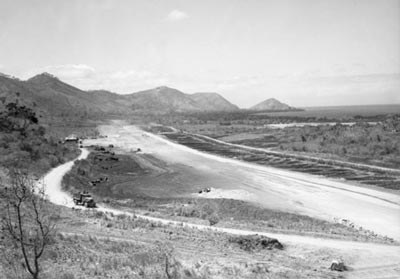 |  |
| Kila Kila Drome, probably soon after it was built | Kila Kila Drome on 27 December, 1943
Looking towards Port Moresby |
Five Mile - Wards Drome
This was located five miles north-east of the town and was very large. Photos show it with numerous taxiways and revetments. It had two parallel 6,000 foot runways. The taxiways actually connected to Seven Mile (see next). Today there are remains of the runways and taxiways seen amongst the industrial estate that covers a large section of the airfield. The Australian High Commission is also on the old airfield, as is Port Moresby's football stadium. The Fifth Air Force's Headquarters was based on the airfield.
Seven Mile - Jacksons Drome
This airfield was built prior to the war. It had two parallel runways and was first used by the Royal Australian Air Force in 1942. It was further developed when American forces arrived in large numbers. This airfield had a specific "crash strip". Pilots flying out of the other four airfields in Port Moresby were advised to use Seven Mile and this particular runway. This was for two main reasons, one, if they crashed on the one strip at Three Mile, it would put that airfield out for an immediate period and may have put it out for an extended time if it was a major crash. Secondly, Seven Mile had better medical facilities.
The alternate name for the airfield was in memory of RAAF pilot squadron Leader John Jackson who was shot down and killed in action April 28, 1942 flying a P-40E.
It is now Jacksons International Airport, the main airport for Papua New Guinea.
89TH BOMB SQUADRON IN PORT MORESBY
In January and March 2006 I received emails from Dick Kelly whose father, John G. Kelly, was a pilot with the 89th Bomb Squadron. John Kelly kept a diary and Dick has provided some details from the diary about what happened to some of the planes and pilots from the 89th.
It appears that when the 89th Bomb Squadron arrived in Port Moresby they may have first been located at Three Mile (Kila Drome). However, as mentioned this was unpaved and in the rainy season it became a bit of a mud pile and huge ruts were moulded in the ground causing problems for the planes. It appears that they moved to Five Mile (Wards Drome) for at least some of the rainy season. On 9 November 1942 Kelly ferried 40-132 on a 20 minute flight. This may have been from Three Mile to Five Mile.
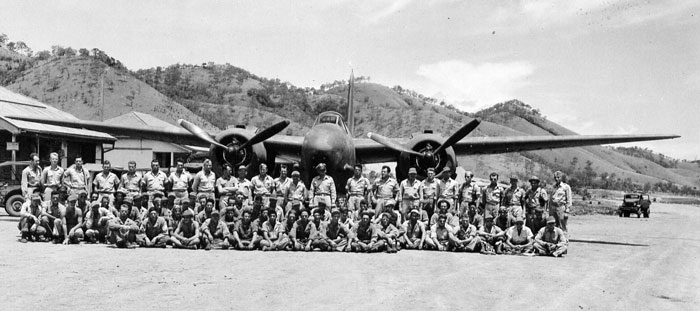 |
| The pilots, gunners and engineers of the 89th Squadron at Kila Kila Drome |
On 4 December 1942 they were still flying out of Wards but they later moved to back to Three Mile. On 10 December 1942 Kelly records ferrying a plane 3159 for 20 minutes. Perhaps this was returning to Three Mile. They also appear to have flown out of Seven Mile as well as the photo of 40-132 "Carolina" at right was taken there (although it is possible that the plane only went to Seven Mile to land because it had problems).
Some Planes of 89th Squadron
| Serial Number | Name | Normal Pilot | Comments | Photo |
| 40-132 | Carolina | John Kelly | Formerly called Dragon Lady and Riff Raff |  |
| 40-173 | Strawberry Roan | (Jarrett) Bill Roan | Formerly called Japanese
Sandman |  |
| 40-176 | Cindy | Edward Richardson | |  |
| 40-3151 | Flying Lawnmower | Bill Beck, although Edward Richardson crashed it | Despite reports, it was never named "Grass Cutter" |  |
| 40-139 | Maid in Japan | Capt Klatt | |  |
| 40-077 | War Bond Special | Riz Lyon | Formerly called "Baby Dumpling" |  |
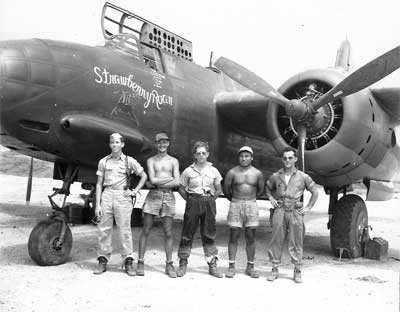 |  |
"Strawberry Roan" with ground and air crew
Bill Roan is on left | "Strawberry Roan" with some of the 89th Squadron pilots
Left to right Edward Richardson, Conn, Mayo, Bill Roan |
History of Some of the Planes
On 2 December 1942 First Lieutenant Edward Ray Richardson crashed the plane 40-3151 "Flying Lawnmower" (see photograph right) when he ran off the end of the runway as the hydraulics had been shot out on a raid to Cape Killertoy (?). This plane was really "owned" by Bill Beck. He is now (2007) the President of the 89/3rd Association which is holding its reunion in Colorado in early 2007.
 |  |
Bill Beck's plane "Flying Lawnmower" after
Richardson crashed landed in December 1942 | A close of of "Flying Lawnmower" showing its logo |
On 8 January 1943, John Kelly crash landed "his" plane 40-132 (which was called "Carolina" after his home region - previously this plane had been called "Dragon Lady" and "Riff Raff"). He had been on a mission to Lae in Papua but as he had hydraulic failure early, he apparently spent more than three hours attempting to get all wheels down. He cranked down the bombay doors but could not get them closed, dropped his bombs and finally he crashed landed at Seven Mile. This was because it had better medical and rescue facilities and so that their own airfield was not put out of action. See the photograph below right. As you can see, the plane's landing gear is not down and it has suffered a fair bit of damage to its fuselage, wings, engines and, of course, the undercarriage.
On 13 February 1943 pictures show Richardson as one of the pilots of 40-173. This plane was "Strawberry Roan" but was formerly called "Japanese Sandman". "Strawberry Roan" was allocated to Lieutenant (Jarrett) Bill Roan. I had been told that the plane's name was because Bill Roan had red hair (funny, if he was an Aussie, his plane would be called "Bluey Roan"!) but Dick Kelly advised me that his mother remembers one of the wives at a reunion of the 89th Squadron having a plane named after her red hair. She believed it was Mrs Roan who she recalled was red headed. I do not know if Roan was married while in New Guinea. In early 2007 I was told he lives in San Antonio, Texas. In February 2017 I was emailed by Bill's daughter (Mary Roan Lang) who advised me that Bill had brown hair as did her mother. The redhead was actually Bill's grandmother, so the plane was obviously named after her.
In December 2007 I got an email from Bill Swain who told me that the aircraft named after a red haired wife was "Kentucky Red" which was named after the wife of its pilot, Jack Taylor.
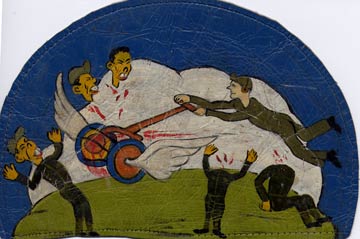 | 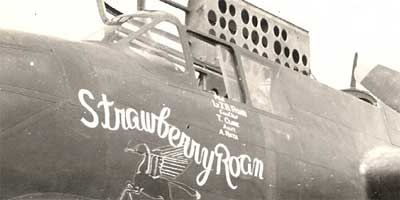 |
A patch made of the logo of Bill Beck's
plane "Flying Lawnmower" which he wore on his flying jacket | "Strawberry Roan" showing that the pilot is Lt J. Bill Roan |
A complicating factor in identifying which of the two planes is the one now located off Loloata Island is that the daughter of Lt Richardson advised me that she has a photograph of "Strawberry Roan" which the family had always been under the impression was their father's plane (see photo top right which is presumably the photo). He certainly flew it but it was not "his" plane. I had hoped to find out more about this but I never heard back from the family. The series of photos on this page of planes, pilots and crew were taken on 13 February 1943 according to John Kelly's diary. It appears that "Strawberry Roan" was just used as a prop for all the pilots to be photographed with. Also, from this we know that "Strawberry Roan" had not crashed by this date.
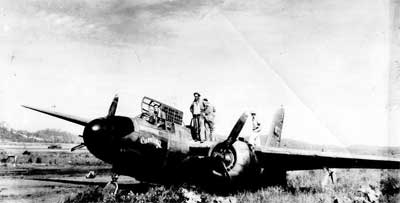 |  |
| "Carolina" after John Kelly crashed it at Seven Mile | "Carolina" with Riz Lyon after he crashed it at Three Mile |
On 24 February 1943 Kelly flew 40-176 on a mission to Mubo. He reports that Bill Roan had engine problems on this mission. As it is likely that Roan was flying "Strawberry Roan", it made it more likely that 40-173 was "Strawberry Roan" and that 40-176 was not. I was then advised by Michael Claringbould (see references) in March 2006 that 40-176 was called "Cindy" and confirming that 40-173 was "Strawberry Roan". Based on Kelly's diary, I knew that sometime after this but probably well before the start of April 1943, Richardson had another crash, this time in 40-176 "Cindy". His gunner was S/Sgt Powell. Powell was normally John Kelly's gunner. Powell ended up in hospital with back injuries. It had to be well before the start of April as Powell was in another crashed on about 10 April, so he had to have recovered by this date. Michael Claringbould advised me in March 2006 that 40-176 crashed on 5 March 43 (the Warbirds-Central Web Site - see references - says that it was lost on 8 March 1943). This fits in with what Kelly's diary says. Claringbould advises that the aircraft ditched close to shore, in Bootless Bay.
In early March 1943 Kelly and Lieutenant Riz Lyons went on leave to Australia. During the time they were away (almost three weeks), it appears that 40-176 crashed, hence the reason there is no more detailed report in Kelly's diary. While they were in Australia, their squadron was involved in heavy fighting in the Battle of the Bismark Sea. When Kelly returned on 18 March 1943 he wrote to his parents that 40-132 "Carolina" had come out of hospital. He flew on 22 March 1943 in 40-139 and on 24 March 1943 he started flying 40-132 again.
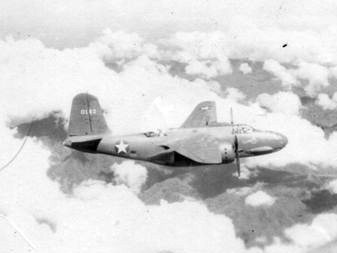 |  |
| "Kentucky Red" | "Kentucky Red" with crew from the squadron |
On 8 and 9 April 1943 Kelly flew 40-132 "Carolina" on missions. On 11 April 1943 Kelly wrote in his diary that "Carolina" was being repaired and needed at least a week more before it would be flying again. Therefore, the second accident to 40-132 "Carolina" must have happened on 10 April 1943. It was being flown by Riz Lyons (whose plane was normally "War Bond Special") when the nose wheel appears to have collapsed when landing. See the photo below left. It had to have been 10 April 1943 as on 24 April 1943 Kelly writes that Lyons' gunner had been S/Sgt Powell and that Powell ended up in hospital again with back injuries. This was his second time in hospital as remember he was in 40-173 when it crashed with Richardson at the controls. Also, Kelly reported on 24 April that Lyons had almost recovered from this second crash when he contracted dengue fever. 40-132 "Carolina" was returned to Kelly on 21 May 1943.
From 13 to 20 April 1943, all the planes in the Squadron were grounded while the fuel systems were changed.
On 20 April 1943 John Kelly was flying 40-173 "Strawberry Roan" when one engine kept cutting out on take-off. He returned 40-173. They were flying out of Three Mile Drome (Kila) at this time. I wonder if this was due to the fuel systems being replaced?
DOUGLAS A-20 AIRCRAFT CRASHED IN WATER IN PORT MORESBY AREA
Two Douglas A-20 Havoc aircraft are recorded as having crashed in the Loloata Island area of Bootless Bay.
40-176 - "Cindy"
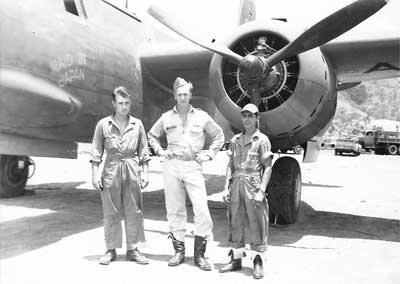 |
| William Langley (centre) in front of "Maid in Japan" |
The first plane is 40-176 "Cindy". As I have indicated above, this was allocated to the 89th Bomb Squadron of the 3rd Bombardment Group. The pilot of 40-176 when it crashed was First Lieutenant Edward Ray Richardson. The gunner was Staff Sergeant D. L. Powell. This plane is reported to have had a port engine failure and crashed on 5 March 1943. Richardson put the plane down in the water in Bootless Bay which is south-east of Port Moresby. This location is in almost a direct line with the runways of Seven Mile. As mentioned earlier, this was the preferred airfield for potential crash landings.
On 19 March 1943 its compete airframe was raised to the surface and completely salvaged by US engineers. It was disassembled and taken back to 3 Mile. The port engine failure corresponds with the plane located off Loloata but since this plane was salvaged, the plane located off Loloata now cannot be 40-176.
40-173 - "Strawberry Roan"
The second plane that is known to have crashed nearby in the water is 40-173. This was called "Strawberry Roan" and as mentioned earlier it was nominally allocated to Lieutenant Bill Roan. The pilot of this plane when it crashed was 2nd Lieutenant William Langley. 40-173 had hydraulic trouble and Langley could not put his landing gear down. To make it worse, one engine cut out. The date given for the crash of 40-173 on the Pacific Wrecks Web Site (see references below) is 23 April 1943. However, John Kelly in his diary says that it happened on 22 April 1943. The web site also says that the starboard engine failed but if this is correct, then the plane I have dived on and which is the subject of this article is not 40-173. The plane crashed landed in Bootless Bay. John Kelly's diary implies that 40-173 was not returning from a mission but perhaps from a training flight or even testing the plane after its engine problems of 21 April. The Warbirds-Central Web Site (see references) says that it was lost on 26 April 1943 in combat, but we know that this was not true. Michael Claringbould says that the plane was on a test flight after its engine problems on 20 April 1943 and this is logical. As for 40-176, this is in an almost direct line with the runways of Seven Mile.
THE CRASH
I had been told that the plane I have dived on was returning from a mission to Guadagasal on the Salamauato Wan track. However, this appears to be incorrect as you will see. Anyway, the story was that the plane was about to turn onto the line for landing at Seven Mile (Jacksons Airfield now Jacksons International Airport). Athough both planes were probably based at Three Mile when they crashed and the location of the wreck is in an almost straight line with the runway at Seven Mile, we know that 40-173 "Strawberry Roan" was not returning from a mission. However, as Seven Mile was the preferred crash airstrip, it was likely that 40-176 was attempting to return to Seven Mile. The plane appears to have suffered an engine failure. The port engine failed on the plane I am writing about (see later why we know this) and this is also the engine said to have failed on 40-176 "Cindy". The starboard engine is said to have failed on 40-173 (according to Pacific Wrecks Web Site as of 20 March 1943) but since 40-176 "Cindy" was salvaged shortly after it crashed, it appears that the only possible plane that this can be is 40-173 "Strawberry Roan". Therefore, this report is incorrect.
 |
| Lt Edward Ray Richardson |
Anyway, as it now appears that the plane off Loloata Island is 40-173 "Strawberry Roan", the following is what happened. The pilot of 40-173 was not Bill Roan but 2nd Lieutenant William Langley with an unknown gunner. The plane was returning to Three Mile parallel to the coast or attempting to line up with Seven Mile when it suffered a port (not starboard) engine failure and Lt Langley lowered the flaps (we know this as they are down now) and made a very successful landing on the water. The plane is said to have spun around 90° to port (left). Langley and his gunner escaped the plane before it sank. This was on 5 March 1943.
Therefore, I believe that the plane is 40-173 "Strawberry Roan".
OTHER INTERESTING THINGS
Lt Richardson completed 59 missions earning two DFCs. After service in the Pacific, he ferried Douglas A-26 Invaders to Europe before being assigned back to the United States. He later became a Captain and after service in the Army Air Corps he went to college and then entered the Army. He rose to the rank of Colonel. Edward Richardson died in December 1976 after a long illness.
In January 1943 Langley and Richardson came to Kelly's tent late one night drunk. They sang Happy Birthday to him, even though it was not his birthday till 14 February 1943 when Kelly turned 23. Kelly went to Brisbane to test fly new A-20s during July and August 1943. He reports that Langley went home in the Summer of 1943 (I assume this is the northern Summer, so he left in about August 1943).
THE DISCOVERY
On 6 November 1980, Dik Knight, owner of Loloata Island, located about 20 km east of Port Moresby, was out snorkelling with a researcher on a reef off the south-eastern end of the island when he spotted the nose of an aircraft. He and the researcher started looking for the plane and within a short time, Dik had found an aircraft. This was the A-20 Havoc.
Today the aircraft is located on the eastern side of a small coral reef at about 16 metres and is buoyed. The actual location of the plane is GPS Reading 9° 33' 07"S 147° 17' 35"E using WGS84.
THE WRECK
The water here is quite dirty and visibility only a few metres. Swim to the buoy before descending (as you may not find it due to poor visibility). You will find that the plane sits relatively flat on the bottom, facing the south with the cockpit (remember the nose is missing) hard against a coral reef. The bottom is about 18 metres or so. Starting from the cockpit, you can see that the gauges have virtually all been stripped from the plane but the seat, throttles, joystick and other controls remain intact. You will see that the propeller of the port engine is intact, not bent back at all. This proves that the port engine was not running when the plane hit the water as if it was, the blades would be bent back like the starboard engine's blades are bent. This shows that the starboard engine was running when the plane crashed. Both wings are intact, with no sign of machine gun damage, further indicating that the cause of the crash was engine failure, unrelated to enemy action.
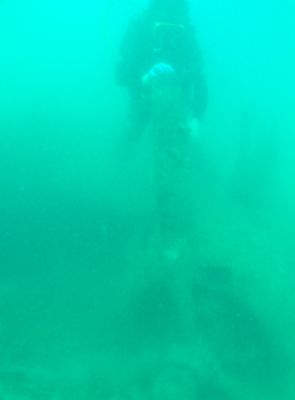 | 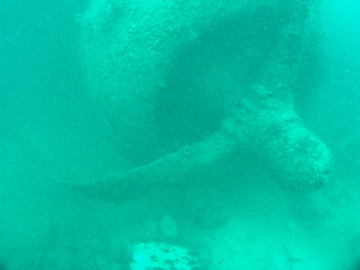 |
The port prop shows no sign of being bent,
this engine was not running when
the plane hit the water | The starboard engine - note that the prop blades
are bent back showing it was running when
the plane hit the water |
As you swim back from the tip of the port wing to the fuselage, you will notice that the port aileron (which was fabric covered, like the tail rudder and tail elevators) is angled up. The corresponding aileron on the starboard side is angled down. This would be as expected if the pilot was struggling with a failed port engine and counteracting the now "heavier" port side. Closer to the plane, both the inboard and outer flaps are fully extended on both wings as would be expected from a controlled forced landing.
Moving towards the tail you will see almost immediately the dorsal gun position. The canopy is missing, presumably discarded by the gunner as the plane prepared for a crash landing. The twin barrels of the machine gun are clearly visible, stowed away in its storage compartment. As mentioned before, the fabric covered rudder and elevators are noticeable on the trailing edges of the tail. The rudder and rudder tab both move, it is possible to push both of them from port to starboard and back again.
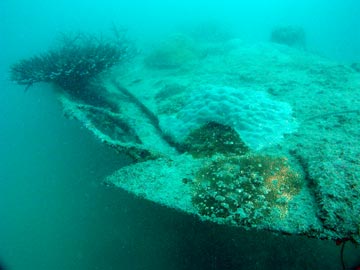 | 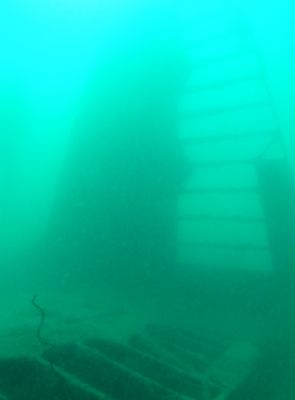 |
| The starboard wingtip | The tail - note the fabric covered
rudder and elevator |
Swimming back along the starboard side of the fuselage and you will come to the starboard wing. You will notice that the blades are bent backwards from contact with the water, indicating that this engine was running when the plane hit the water. You will also see that the bend in the blades is not as dramatic as the blades on the Republic P-47D Thunderbolt located a little to the north. This is probably because the Havoc landed much slower than the Thunderbolt (which has its flaps up compared to full flaps on this plane).
If you have not already checked, examine the engine nacelles and you will see that the plane does not appear to have the rear mounted machine guns that are sometimes included on the A-20A models. As mentioned earlier, the nose o fthe plane is missing. It is apparently located 50 metres away, but without knowing which direction, it would be very hard to find.
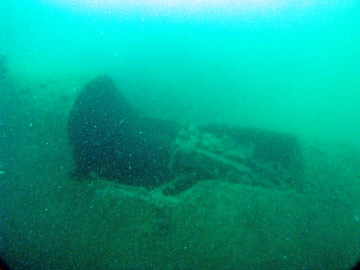 | 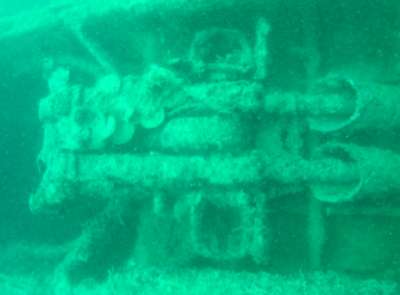 |
| The dorsal gunners compartment | The dorsal gun in its compartment |
This is a very interesting dive, especially for aircraft and World War II enthusiasts. Visibility on the day I dived it was perhaps three metres and water temperature 26°.
Dive Operators:
 |
| The flaps are clearly down indicating a controlled landing |
I dived here with The Dive Centre which is located in Port Moresby at Ela Beach. It operates the Solatai (built in 1979 for Bob Halstead), a large and slow but comfortable boat capable of carrying well over a dozen divers in comfort. Solatai is based in Bootless Bay, a 15 to 20 minute run to the south-east of the city. The Dive Centre will pick you up in Port Moresby and transport you to Bootless Bay (cost 20 kina return). Double dives, including tanks, weights, refreshments (tea or coffee on arrival and between dives, hot noodles and biscuits between dives) cost 135 kina and a triple dive 190 kina. This represents excellent value, for two dives with transport the cost was 155 kina, equal to A$62. The dive operation is owned by John Miller and his service, as well as that of his employees, Thomas (skipper and dive master) and Ghetto (boatie) was excellent. I can certainly recommend this operation to all divers.
You can also dive here using Loloata Island Resort. You can either stay there or stay in Port Moresby and get transported each day (which I understand they will also do).
Notes:
Dives:
3rd Bombardment Group Reunion:
 |
A photograph taken from a reunion held on 26 April 2008
Ed Shook, Jack Sturla, Bill Webster, Jack Taylor, Bill Beck, Francis LaClair, Peter Palmos, Tony Anselmo, Fred Klatt, John Field,
(sitting l-r) Melvin Freeman, Arthur McCain, Bob Reed, Joe Long, Robbie Robinson, & Dick McKinney
Photo by Mary Henebry |
References:
| 
 v6.00.307 © 2003-2005
v6.00.307 © 2003-2005